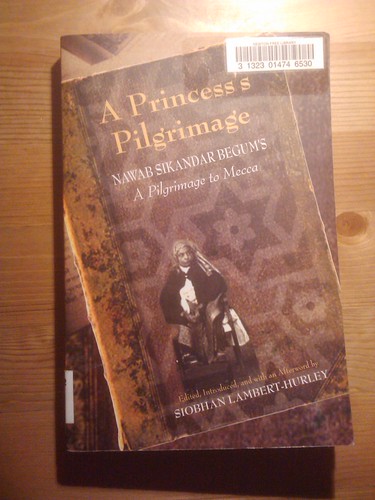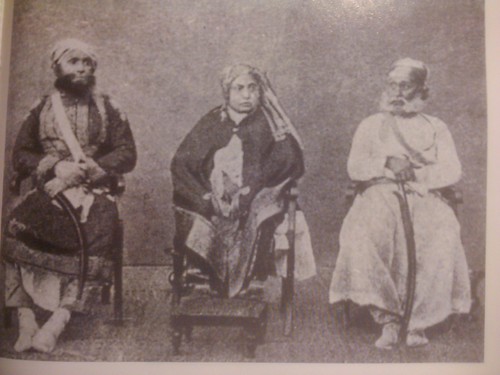By Kashif-ul-Huda, TwoCircles.net
Hajj is one of the five pillars of Islam and for over fourteen hundred years a journey of a lifetime for millions of Muslims living in different corners of the world. These hajis returned to their homelands to tell a tale of physical and spiritual journey of extraordinary proportions. Hajj is obligatory for every Muslim man and woman who are able to undertake this journey. A large number of Muslim women from India made this pious trip but one of the first to write an account of her hajj journey was Nawab Sikandar Begum of Bhopal.
Nawab Sikandar Begum (1816-1868) ruled Bhopal from 1844 to 1868. She went on Hajj in 1284 Hijri (1863-4 CE). The account of her travel was first published in 1870. It was a translation by the wife of a British officer. The original Urdu manuscript is perhaps lost so we will never know what kind of language the Begum used in her writing but her confidence and views of the Hijaz and its inhabitants come across just fine.
Sikandar Begum has the unique distinction of being the first Indian ruler to make the hajj journey. Even with their proclamation of love for Islam none of the Muslim rulers of India went for hajj because it was a long and dangerous travel. Nawab Sikandar Begum went for hajj with a party of about 1000 people of which were mostly women.

Book cover
Her memoir, written after her return from Hajj was translated, edited, and published after her death. First thing one notices about this memoir is how little is mentioned about the Hajj itself. Nawab Begum gives a detailed account of her problem with Turkish customs who insisted on charging duties on every item that she brought with her. She also talks at length about her dealings with the Pasha and the Shariff of Hijaz. When she mentions hajj it is when she talks about her writing letters to Pasha and Shariff for making arrangements for her rented houses and camps that she was going to set up in Arafat and Mina.
As an able administrator who impressed the British with her skills, she had a keen eye on the cities that she stayed in during her visit to the holy land. She finds Jeddah and Makkah dirty and Arabs and Turkish there uncivilized in their behaviour. She is also not impressed by their religious knowledge. Lack of knowledge about Islam among the Turks and Arabs prompted her to commission a Turkish translation of the Quran.
Though this piece of travel writing provides no insight in the spiritual status of the Begum but this provides a rare glimpse into the confidence of this woman ruler from India. She talks on an equal terms to both Turkish administrator (Pasha) and local Arab Emir (Shariff). In fact, she does not hesitate in giving them advise on how best they can administer the city. She is also aware and fond of new technology and thinks it is essential for better government.
Overall, the Begum was frustrated by the apalling condition of the cities, strange customs, and her inability to communicate properly. At one time she instructed the guards to let in only those women who can speak “Hindustani.” She felt alienated from the customs of this land and though she was Muslim just like these Arabs and Turks yet she could find no way to connect.
Soon after her arrival in Makkah, she managed to anger the Sharif because she failed to let him properly honor her. She wrote a letter explaining and excusing herself and she give reference to an Indian custom to explain why her mother is living in a different house but later in the same letter she does not hesitate to say that as an Afghan she pays great respect to Syeds and therefore she has utmost respect for the Sharif.

Sikandar Begum flanked by her Minister, Maulvi Jamaluddin (left) and Army Chief, Mattu Khan. [Photo from the book “The Begums of Bhopal” by Shaharyar M. Khan]
Begum during her stay in Hijaz sensed that some people were not happy with her there because she had sided with the British during the war of 1857. The State of Bhopal remained a loyal friend to the British since entering into a treaty with the British East India in 1818. Begum was rewarded handsomely for her loyalty. She was honored with the title of Knight Grand Commander making her only the second female to be made a knight after Queen Victoria herself. Begum was also to successfully argue her case to be declared the ruler of Bhopal and won that case. Her power of persuasion also ensured that Bhopal continued to be ruled by her daughter and after that by her grand daughter.
Sikandar Begum was a religious lady. She offered her five-time daily prayers and performig hajj was yet another symbol of her piety. She is also credited with getting Delhi’s Jama Masjid which was closed since the fall of Delhi in 1857. During her visit to Delhi in 1862, she got the British to get it opened and she is reported to have cleaned it by her own hands and the first person to pray there.
Nawab Sikandar Begum was the first ruler but not the first prominent Muslim women from India to go for Hajj. Before her, we have examples of Bega Begum, a wife of Humayun’s officer who later married Humayun and was famously known as Haji Begum.
Gulbadan Begum was the most prominent Mughal princess to go for Hajj. She was a daughter of Babur and she along with a number of ladies were sent by Hajj by Emperor Akbar. Similarly, ladies of Golconda and Bijapur also have been recorded as making this trip.
A Princess’s Pilgrimage: Nawab Sikandar Begum’s A Pilgrimage to Mecca
Edited by Siobhan Lambert-Hurley
Indiana University Press 2008.

